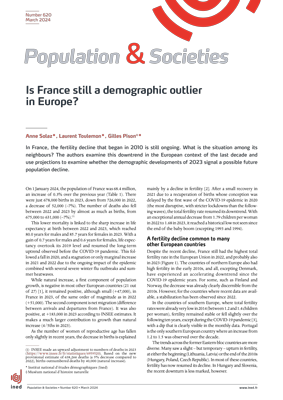Is France still a demographic exception in Europe?
Press release Published on 18 March 2024

Authors: Anne Solaz (INED), Laurent Toulemon (INED), Gilles Pison (Muséum national d’histoire naturelle, INED)
Recent decreases in fertility in France have been widely discussed. But how does the country compare to its neighbours? The authors situate this fall in the European context of the last decade, and use projections to examine whether the demographic changes of 2023 might presage a decline in the French population in the decades to 2070.
Declining fertility...
On 1 January 2024, France had 68.4 million inhabitants, 0.3% more than a year earlier. Births fell sharply in 2023, from 726,000 in 2022 to 678,000, a decrease of 52,000 (7%). At 1.79 children per woman in 2022, France’s fertility rate was the highest in the European Union. This likely remained true in 2023 despite a decline to 1.68 children per woman. Looking at Europe as a whole, fertility is now more homogeneous than it was a decade ago, despite the unequal effects of the ‘COVID-19 shock’. Fertility has been declining in almost all countries in the region since 2010, as it has in many other world regions.
…but positive natural increase
In 2023, France’s natural increase (the difference between the numbers of births and deaths in the country) was positive, if low, at 47,000. This contrasts with most European countries: natural increase was negative in 21 out of 27 EU countries. A decrease in the number of deaths is linked to a sharp increase in life expectancy at birth between 2022 and 2023 (+0.7 year for men and +0.6 year for women). Net migration (the difference between the number of people who entered the country and the number who left) remained positive in 2023. At an estimated 183,000 (INSEE), it contributed more to population growth than natural increase (four fifths of the total).
Lower fertility, higher net migration: what are the effects?
In November 2021, INSEE published its population projections for France up to 2070 based on the demographic trends of the previous years. In INSEE’s central scenario, the population of France continues to increase until it reaches a maximum of 69.3 million in 2044, before decreasing to 68.1 million in 2070. But the changes observed since the publication of these projections led the authors of this edition of Population & Societies, who are INED researchers, to produce new projections. In these new projections, fertility remains stable at the 2023 level, at 1.68 children per woman (rather than the 1.8 used in INSEE’s central scenario), and net migration remain stable at 180,000 per year (rather than the 70,000 used in INSEE’s 2021 central scenario). For mortality, the INSEE assumptions on increasing life expectancy were kept unchanged.
Future changes remain uncertain, but according to the scenario presented by the authors, high net migration could more than compensate for lower fertility if both remain at 2023 levels; as a result, the French population would continue to grow until 2070, to 72.1 million.
Published on: 20/03/2024








